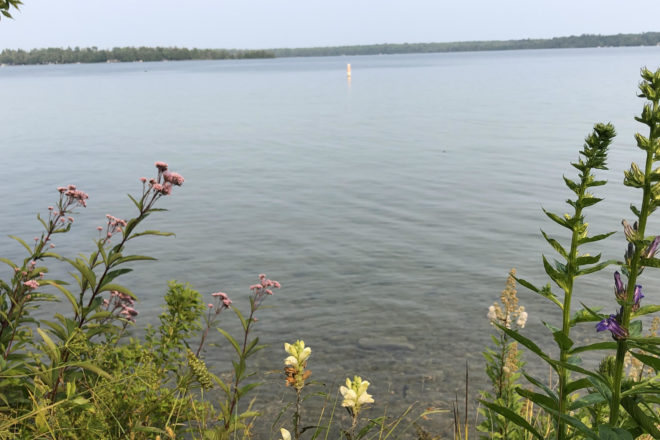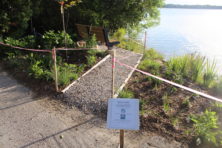Owners Association Increases Efforts to Protect Clark Lake
- Share
- Tweet
- Pin
- Share

The Door County Invasive Species Team (DCIST) has made two presentations during recent weeks to Clark Lake neighborhood residents who want to take steps to protect the lake and shoreline.
DCIST coordinator Samantha Koyen said the Clark Lake Advancement Association (CLAA) has been seeking shoreline-planting and protection grants and has already set an example of what should and should not be growing along the shoreline.
Near the boat ramp at West Townline Road, for example, the association has a very short pathway and bench looking out over the lake that’s surrounded by native, noninvasive plants that can improve landscapes and help to prevent shore erosion and runoff from shoreside lawns.
“It’s really pretty, and it works great,” Koyen said of the CLAA Natural Shores Demonstration Project, which includes an identification map and signs for black-eyed Susan, joe-pye weed, turtlehead, wild bergamot, native rushes, dwarf common ninebark, native potentilla, swamp milkweed, common milkweed, golden Alexander and more. Koyen said the plants also attract pollinators while providing natural diversity to “eco-transition areas.”
This summer, the association is encouraging residents and owners to plant native species along their lakefront, said Chuck Birringer, a CLAA director for more than 30 years. During the association’s annual meeting, committee members invited neighbors to get involved with a program nicknamed Buffer Buddies, and to plant 100-square-foot native-plant plots.
“We now have a small group of people that we’ve recruited around the lake who want to add native plants,” CLAA member Mark Wiesse said.
He and the group can help neighbors choose plants that are appropriate to their soil, topography, proximity to the water and sun exposure.
“None of us had much experience identifying the plants, so Samantha Koyen said she would come and meet with the owners, and go to the properties and walk through, and let them know what were the good plants to keep and what would fit into the small spaces,” Wiesse said. “Most are doing a 10-by-10-foot square. One is doing 20 by five feet. One of our natural shore goals is to have a minimum of 35 feet of native vegetative buffer along the shoreline.”
Koyen advised members to use many of the plants on the shoreline plot and also to plant native shrubs such as osier dogwood.

In addition to plant identification and selection, the association members keep an eye on boat-ramp areas and shoreline areas to see where nonnative plants such as invasive tall grass and phragmites keep popping up along the north bay. Another member has been taking water samples to determine whether fertilizer runoff is contributing to aquatic weed growth.
“You have to keep at it every year,” Birringer said. “You can’t just get at it one time.”
Wiesse encourages participants to help the CLAA compile an inventory of plants along the lakeside. He’s willing to help people find locally grown plants, forbs and seeds, too.



